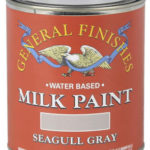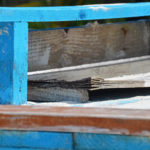Unfinished cabinets can make a kitchen feel unfinished. However, they don’t have to. Painting them is not as difficult as you might think and will give your home a new look.
This article discusses the steps in painting un-stained or unfinished cabinets with an oil-based primer, latex paint, and wax sealer.
Step 1: Clear Out The Cabinets
You will want to remove everything from your cabinets and wipe down the inside of them with a damp rag. Put all of your items that you removed in boxes or bags so they are not lying around as paint gets everywhere.
Step 2: Clean Your Cabinets
Cabinet preparation is a necessary first step when painting cabinets. The raw wood surfaces need to be clean, dry, smooth, and free of grease or dirt buildup to accept an even coat of paint that will prevent peeling later on.
Start by removing all doors and drawers. Clean your cabinet and get it ready for painting by washing with warm water. Make sure any wax or oils are removed from the surface as well.
Use an oil spot remover if necessary to remove stubborn stains that cannot be wiped off after a few minutes of scrubbing with soap and water.
Step 3: Use Sandpaper
Most important, the painted surface must be chemically sound to provide a good foundation for the new paint.
The first step to painting cabinets is to sand them down with fine-grit sandpaper (120-220). Sand in all directions for consistent coverage. Ensure you wear gloves, eye protection, long sleeves, etc.
Sand the unfinished cabinets using an orbital sander or a belt sander with the 120-grit paper if possible.
Once sanding is complete, use a damp rag to wipe down your cabinets to remove any dust particles that were created by the sanding.
Step 4: Fill Holes and Cracks With Wood Filler
Depending on your cabinets’ condition, you might need to fill in small holes or gaps with wood putty before applying primer. Use spackle or epoxy-based wood filler (not caulk) for larger holes. Use a putty knife to apply wood filler, and then sand it flat once dry (as per manufacturer’s instructions).
Step 5: Remove the Dust
Next, clean your cabinets again with a degreaser and water-dampened rag to ensure no dust is left behind or you missed during your first cleaning. Use an old toothbrush to get into corners or crevices where dirt may have been hiding.
Step 6: Vacuum Your Cabinets
Vacuum your cabinets thoroughly using an upholstery attachment if possible to remove any loose debris that will ruin your paint job down the line. Repeat this process once before you actually start painting to ensure all dust has been removed.
Step 7: Allow to Dry Completely
Wait until the cabinets are completely dry before moving on. If you paint when they’re still wet, your new finish will be ruined.
Step 8: Apply an Oil-based Primer
The oil-based primer will create an effective seal on unfinished surfaces. With the help of a small paintbrush or foam brush, spread the primer onto the wood surfaces, and then use a roller to smooth out any brush strokes.
Wait 24 hours after the first coat of primer before applying another one to ensure it is dry. The second coat should be applied like the first one – spreading evenly across all surfaces until no white spots remain visible on your wood.
Step 9: Apply a Latex Paint Using a Roller or Spray Gun
It’s best to avoid painting unfinished cabinets in high humidity areas or when there is rain expected within six hours of starting the project because these conditions can cause peeling and bubbling under your paint.
Apply two coats of latex paint using a paintbrush or roller, depending on the surface. It is best to use a semi-gloss finish for cabinets so you can wipe away fingerprints and water spots with ease later on.
A roller works best for flat surfaces, but spray guns can be very effective too – depending on your skill level and comfort with painting cabinets. Use an angled brush if you need to get into nooks or crannies.
Wait until the cabinets are completely dry before applying a coat of wax sealer. If you paint when they’re still wet, your new finish will be ruined and it may peel off in sheets instead of having a smooth finish that lasts for years.
Step 10: Apply a Coat of Wax Sealer
Wax the cabinets after they have dried completely in order to protect them from moisture and stains. Make sure that you wax between each coat of paint since this is how your finish will be applied properly. If done correctly, these steps can make a big difference.
Apply one coat of wax sealer, and once that is dry you can apply another if desired. Allow the final paint job to cure for at least 72 hours before using the cabinets again to prevent smears or fingerprints from ruining your finish.
Wait until everything feels completely solid (no longer tacky or sticky) before placing items on your newly painted cabinets.
Step 11: Reassemble the Cabinets
Once your painted cabinets are fully dry (usually overnight), you can attach the cabinets, putting back the doors and drawers. Your newly painted cabinet is now ready for use!
You may need to touch up some areas after opening drawers or doors for a while, but overall you will be amazed at how good your cabinets look with a fresh new paint job.
Conclusion
When renovating your kitchen, the last thing you want to do is have unfinished cabinets. But if it seems like painting them will be challenging and time-consuming for a job that isn’t too difficult – think again!
Painting un-stained, unfinished cabinets can give any room in your home an instant facelift without costing a fortune. This article discusses the steps involved with priming, painting, and sealing your cabinet doors so they are ready to use as soon as possible.
Consider some of our tips when planning out how best to decorate your new space.




